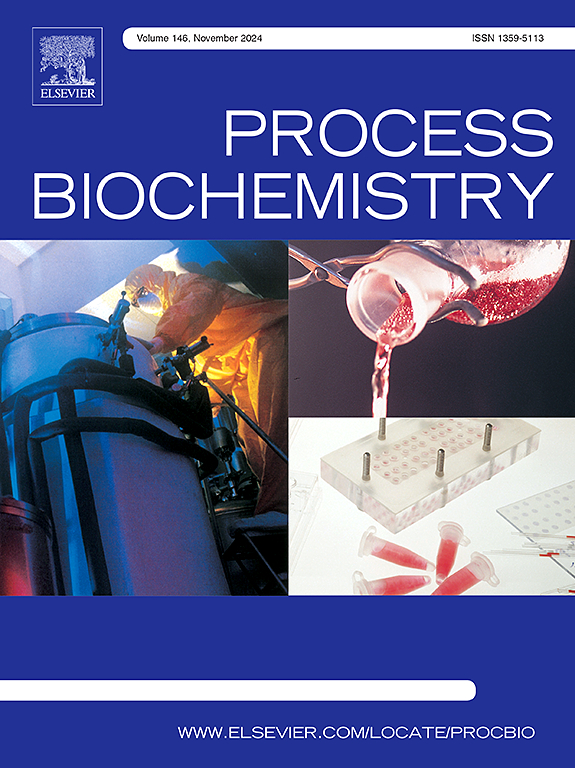探索在木质纤维素生物质水解模拟培养基中解脂耶氏菌的脂质和柠檬酸生产:培养操作模式的影响
IF 4
3区 生物学
Q2 BIOCHEMISTRY & MOLECULAR BIOLOGY
引用次数: 0
摘要
本研究探讨了两株解脂耶氏菌W29和NCYC 2904在桉树树皮水解模拟培养基(EH-MM)中分批、补料分批和重复分批培养产生富含脂质生物质和柠檬酸的潜力。考虑到木质纤维素水解物组成的可变性,在批量模式下评估了葡萄糖、木糖、乙酸、甲酸和5-羟甲基糠醛浓度不同的两种EH-MM配方。在100 g⋅L−1葡萄糖浓度下,两株菌株均无生长抑制,但在50 g⋅L−1葡萄糖浓度下,脂质积累最高。在浓度最高的培养基中,W29的柠檬酸产量最高(44 g⋅L−1)。补料间歇模式增加了NCYC 2904的脂质含量(51% %)和W29的柠檬酸含量,而重复间歇模式与其他策略相比,提高了生物质产量和脂质滴度。NCYC 2904在两段重复分批培养中获得最高的生物量(66 g⋅L−1)和脂质浓度(25 g⋅L−1),第一批C/N为10,第二批为75。积累的脂质主要由油酸、棕榈油酸和棕榈酸组成,表明它们具有作为生物燃料原料的潜力。总体而言,研究结果表明,W29分批培养柠檬酸和NCYC 2904两阶段重复分批培养脂质是实现木质纤维素衍生糖的有前途的策略,强调了菌株选择和操作模式在生物炼制设计中的重要性。本文章由计算机程序翻译,如有差异,请以英文原文为准。
Exploring lipids and citric acid production by Yarrowia lipolytica in lignocellulosic biomass hydrolysate-mimicking media: Effect of cultivation operation modes
This study explores the potential of two strains of Yarrowia lipolytica, W29 and NCYC 2904, to produce lipids-rich biomass and citric acid under batch, fed-batch, and repeated-batch cultivation in a eucalyptus bark hydrolysate-mimicking medium (EH-MM). Considering the variability in lignocellulosic hydrolysates composition, two EH-MM formulations, differing in glucose, xylose, acetic acid, formic acid, and 5-hydroxymethylfurfural concentration, were evaluated in batch mode. No growth inhibition was observed at 100 g⋅L−1 glucose, but lipids accumulation was highest at 50 g⋅L−1 glucose for both strains. The highest citric acid production (44 g⋅L−1) was achieved with W29 in the most concentrated medium. Fed-batch mode increased lipids content in NCYC 2904 (51 %) and citric acid in W29, whereas repeated-batch enhanced biomass production and lipids titers compared to the other strategies. The highest biomass (66 g⋅L−1) and lipids concentration (25 g⋅L−1) were obtained with NCYC 2904 in two-stage repeated-batch culture, with a C/N ratio of 10 in 1st batch and 75 in 2nd batch. The accumulated lipids were mainly composed of oleic, palmitoleic, and palmitic acids, suggesting their potential as biofuel feedstock. Overall, the results indicate that batch cultivation of W29 for citric acid and two-stage repeated-batch cultivation of NCYC 2904 for lipids are promising strategies for valorizing lignocellulose-derived sugars, underscoring the importance of strain selection and operation mode in biorefinery design.
求助全文
通过发布文献求助,成功后即可免费获取论文全文。
去求助
来源期刊

Process Biochemistry
生物-工程:化工
CiteScore
8.30
自引率
4.50%
发文量
374
审稿时长
53 days
期刊介绍:
Process Biochemistry is an application-orientated research journal devoted to reporting advances with originality and novelty, in the science and technology of the processes involving bioactive molecules and living organisms. These processes concern the production of useful metabolites or materials, or the removal of toxic compounds using tools and methods of current biology and engineering. Its main areas of interest include novel bioprocesses and enabling technologies (such as nanobiotechnology, tissue engineering, directed evolution, metabolic engineering, systems biology, and synthetic biology) applicable in food (nutraceutical), healthcare (medical, pharmaceutical, cosmetic), energy (biofuels), environmental, and biorefinery industries and their underlying biological and engineering principles.
 求助内容:
求助内容: 应助结果提醒方式:
应助结果提醒方式:


